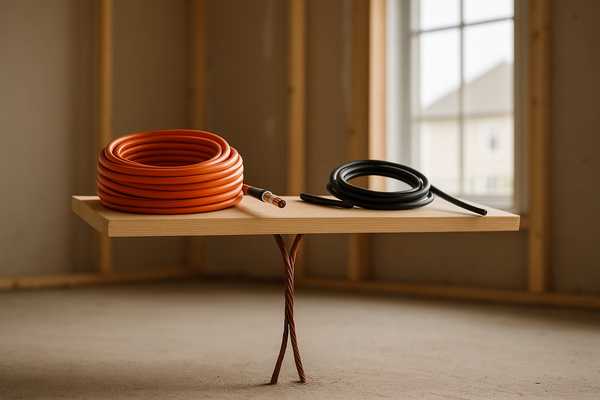How Copperweld® Building Wire Meets Growing Electrical Demands of Today’s Homeowners

How Copperweld® Building Wire Meets Growing Electrical Demands of Today’s Homeowners
by Dustin Smith, Copperweld
Brentwood, Tenn., Nov. 4, 2025 — Copperweld offers a future-ready solution that’s energy efficient, sustainable, and code-compliant.

Modern Homes Require More Wire
From EV chargers and induction ranges to smart lighting systems and whole-home battery backups, today’s homes are more power-hungry than ever. That requires smarter use of resources — improving energy efficiency, conserving copper and maximizing the value of the home. For builders and electricians, it means more wire to support additional devices, circuits and more demanding electrical layouts.
More Wire, More Impact
Over the past 50 years the average size of a new U.S. home has grown by more than 60% while the number of electrical outlets per home has nearly doubled. Rooms that once needed a single circuit now often require two or more. Where 1,000 feet of NM-B building wire might have sufficed in the 1970s, today’s code-compliant homes — especially those with smart devices, open layouts and EV charging — can require two to three times that amount.
This increase has real consequences for electrical contractors and builders:
- More wire means more exposure to copper price fluctuations.
- Longer branch circuits in larger homes can lead to higher energy loss if not managed well.
- Higher electrical demand per room makes conductor performance and consistency more important than ever.
- Every added foot of wire increases environmental impact, making efficient, copper-conscious choices more valuable.
The more wire a home requires, the more important each foot becomes — selecting the right material can make a measurable difference in cost, efficiency and long-term reliability.
When Traditional Materials Fall Behind Modern Needs
Solid copper NM-B has long been the standard for residential wiring, but its drawbacks are more apparent as demand grows:
- Copper price volatility can derail project budgets mid-build.
- Traditional copper wiring consumes more of a critical mineral resource even when alternatives exist.
- Copper theft remains a real threat on job sites.
For projects with growing circuit counts and tight margins, copper wire can look increasingly like an outdated solution.
Enter Copperweld Building Wire
Copperweld Copper-Clad Aluminum (CCA) Building Wire offers an alternative that meets both performance and budget demands. By metallurgically bonding a layer of oxygen-free copper over an aluminum core, Copperweld Building Wire provides the electrical conductivity of copper where it matters most while delivering the cost and weight advantages of an aluminum core.
That bimetallic construction gives Copperweld Building Wire its defining characteristics: high conductivity at the surface, lighter weight and lower cost thanks to the aluminum core, greater resistance to copper price volatility, and reduced incentive for theft. These physical and economic factors combine to deliver immediate and long-term advantages in residential wiring systems.
A Proven Track Record
CCA building wire has been used safely in homes for more than 50 years. Copperweld continues that legacy with extensive testing, quality controls and validation to ensure it meets expectations of homeowners and builders. CCA meets applicable UL safety standards and NEC code requirements and has been used across thousands of residential installations.
Reliable, High-Performance Wiring
Energy-saving electrical characteristics
Copperweld Building Wire helps support performance, reliability and energy efficiency — and supports more sustainable building practices:
- Reduced resistance minimizes energy loss over long runs.
- Stable ampacity supports today’s higher-demand branch circuits.
- Reliable connections hold up when installed with standard, code-compliant methods.
These attributes can benefit electricians and homeowners alike, potentially contributing to lower electric bills over time.
Future Ready
Built to evolve with you. While Copperweld NM-B Building Wire is ideal for today’s branch circuits, its performance also supports longer-term changes: kitchens remodeled, EV chargers added, rooms repurposed as home offices. As energy demands grow and new technologies emerge, Copperweld NM-B provides a strong, efficient foundation that scales with a home’s needs.
Confidence for the long term. Copperweld Building Wire isn’t just a short-term choice — it’s an infrastructure investment designed to support evolving smart-home demands. It delivers the conductivity contractors need, the efficiency homeowners want, and the cost control builders depend on.
Learn more about Copperweld building wire products: Copperweld building wire products.
Sources
- Home size increase (last 50 years): U.S. Census Bureau, Characteristics of New Housing: 1973–2022; National Association of Home Builders.
- Increase in outlets, switches and circuits: National Fire Protection Association, National Electrical Code® editions; Electrical Business Magazine.
- Increase in wire footage per home: Electrical Contractor Magazine; National Electrical Contractors Association (NECA) benchmarking reports.
Copperweld is the world leader in bimetallic wire and cable, specializing in power and grounding conductors for building construction, power grid, utilities, communications and transportation. For more than 110 years, Copperweld’s metallurgical expertise and value-engineering approach have produced bimetallic products that serve multiple industries. Copperweld manufactures in the United States and continues to focus on innovation and quality.
Copperweld® Copper-Clad Aluminum (CCA) Building Wire is engineered for modern residential, multifamily and commercial construction. Code-compliant and easy to install, it stabilizes project costs, improves cycle times, reduces theft incentives and supports sustainable building practices through lower copper usage and improved energy efficiency.
SOURCE Copperweld
